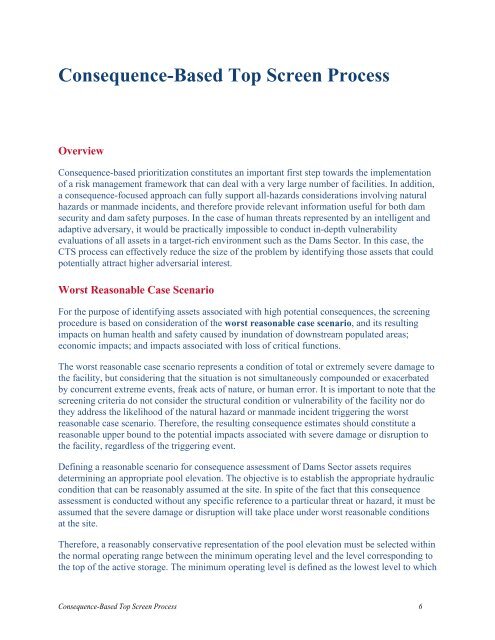Dams Sector Consequence-Based Top Screen Methodology
Dams Sector Consequence-Based Top Screen Methodology
Dams Sector Consequence-Based Top Screen Methodology
Create successful ePaper yourself
Turn your PDF publications into a flip-book with our unique Google optimized e-Paper software.
<strong>Consequence</strong>-<strong>Based</strong> <strong>Top</strong> <strong>Screen</strong> Process<br />
Overview<br />
<strong>Consequence</strong>-based prioritization constitutes an important first step towards the implementation<br />
of a risk management framework that can deal with a very large number of facilities. In addition,<br />
a consequence-focused approach can fully support all-hazards considerations involving natural<br />
hazards or manmade incidents, and therefore provide relevant information useful for both dam<br />
security and dam safety purposes. In the case of human threats represented by an intelligent and<br />
adaptive adversary, it would be practically impossible to conduct in-depth vulnerability<br />
evaluations of all assets in a target-rich environment such as the <strong>Dams</strong> <strong>Sector</strong>. In this case, the<br />
CTS process can effectively reduce the size of the problem by identifying those assets that could<br />
potentially attract higher adversarial interest.<br />
Worst Reasonable Case Scenario<br />
For the purpose of identifying assets associated with high potential consequences, the screening<br />
procedure is based on consideration of the worst reasonable case scenario, and its resulting<br />
impacts on human health and safety caused by inundation of downstream populated areas;<br />
economic impacts; and impacts associated with loss of critical functions.<br />
The worst reasonable case scenario represents a condition of total or extremely severe damage to<br />
the facility, but considering that the situation is not simultaneously compounded or exacerbated<br />
by concurrent extreme events, freak acts of nature, or human error. It is important to note that the<br />
screening criteria do not consider the structural condition or vulnerability of the facility nor do<br />
they address the likelihood of the natural hazard or manmade incident triggering the worst<br />
reasonable case scenario. Therefore, the resulting consequence estimates should constitute a<br />
reasonable upper bound to the potential impacts associated with severe damage or disruption to<br />
the facility, regardless of the triggering event.<br />
Defining a reasonable scenario for consequence assessment of <strong>Dams</strong> <strong>Sector</strong> assets requires<br />
determining an appropriate pool elevation. The objective is to establish the appropriate hydraulic<br />
condition that can be reasonably assumed at the site. In spite of the fact that this consequence<br />
assessment is conducted without any specific reference to a particular threat or hazard, it must be<br />
assumed that the severe damage or disruption will take place under worst reasonable conditions<br />
at the site.<br />
Therefore, a reasonably conservative representation of the pool elevation must be selected within<br />
the normal operating range between the minimum operating level and the level corresponding to<br />
the top of the active storage. The minimum operating level is defined as the lowest level to which<br />
<strong>Consequence</strong>-<strong>Based</strong> <strong>Top</strong> <strong>Screen</strong> Process 6

















